Ever looked up at the night sky to see a full moon so close you could almost touch it? Well done, you’ve spotted a supermoon.
The impressive sight happens when a full moon is closest to Earth. It orbits our planet in an oval shape so sometimes it comes closer to us than at other times. To us Earth-lings, the moon appears 30 per cent brighter and 14 per cent bigger.
By the way, supermoon is not an astrological term. It’s scientific name is perigee-syzygy, but supermoon is more catchy, and is used by the media to describe our celestial neighbour when it gets up close.
Astrologer Richard Nolle first came up with the term and he defined it as “… a new or full moon which occurs with the moon at or near (within 90 per cent of) its closest approach to Earth in a given orbit”, according to earthsky.org.
More about the moon:
The moon is the Earth’s only natural satellite. It’s 4.6 billion years old and was formed between 30-50 million years after the solar system was formed.
The moon is smaller than Earth. It’s about the same size as Pluto. In fact its surface area is actually less than the surface area of Asia – about 14.6 million square miles, according to space.com.
A new moon occurs every 29.5 days. The moon ‘disappears’ from the sky when it is between Earth and the sun with it’s illuminated side facing away from us.
When the moon is opposite the sun we see a full moon as it’s fully lit up by the sun. In between, we see a crescent moon as only some reflected sunlight is seen.
The moon has earthquakes, caused by the gravitational pull of Earth. Experts believe the moon has a molten core, just like Earth.



